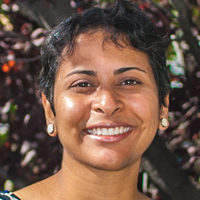
When Superstorm Sandy blew through Staten Island in 2012, Joe’s asphalt and concrete equipment was washed away along with $19 billion of New York infrastructure. A business owner in his early 60s, Joe owned his dump trucks, pavers, and rollers outright. Now he was left with two months of payroll and small hope of keeping his business afloat.
Joe was one of the business owners, residents, and policy makers that Divya Chandrasekhar, Assistant Professor in City and Metropolitan Planning and GCSC faculty affiliate, interviewed for her three-year NSF study on community recovery in post-Sandy New York.

Chandrasekhar’s study investigates the factors that households and businesses depend on for recovery, and how they leverage these factors. Chandrasekhar proposes that if city planners know how households and businesses recover, within the broader context of policy limitations, they can plan for recovery even before a disaster occurs.
Her study has demonstrated that a critical factor in disaster recovery is social capacity, which she describes as “the activation of social capital.”[bs_lead] In other words, people rely on their network of relationships to recover.[/bs_lead]
“Social capital is one of the worst affected resources after a disaster,” Chandrasekhar said. “But it’s also the first thing that people go to when a disaster strikes.”
Post-Sandy, most people in Chandrasekhar’s study obtained their information – about the storm, about government aid, about insurance – from friends and family. Chandrasekhar is discovering that this social capital is also the first (and in many cases, last) stop for obtaining loans and financial support, filling in the gaps between undelivered government aid and ineffective insurance response.
Take Joe, for example. Six months after her initial interview with Joe, Chandrasekhar received a mass e-mail update from the Staten Island Economic Development Corporation describing Joe as a recent grant recipient. She decided to do a follow-up interview on this surprising turn of events. She learned that while Joe did receive a grant from this neighborhood-based organization, it still wasn’t enough to repurchase his equipment. He had to take out an additional $250,000 small business loan, one that he expects he’ll be paying off the rest of his life.
“Even though he got this grant to help, now he also has a debt,” Chandrasekhar explained. “The picture of recovery thus becomes so much more complex. Recovery is not just about availability of resources – like government grants – but also their adequacy.”
Debt notwithstanding, Joe might be the closest thing to a success story when it comes to post-disaster business recovery. According to the Institute for Business and Home Safety, 25 percent of businesses do not reopen following a disaster. Grants such as the one that Joe received are rare, and in New York, the paperwork required for such grants and loans is mired in onerous processes. Yet, business owners like Joe who do persevere often rebuild in their original location, despite a changing climate’s promise of future superstorms. Why?
“Businesses are operating as social units,” Chandrasekhar said. “They have a place-based attachment to their neighbors and neighborhoods – they aren’t making decisions about whether to stay or go just based on economic factors.”
Businesses use their social capacity to provide the resources they need to recover. Owners often borrow money from family and friends, and receive in-kind support like a couple months of free rent from their landlord. During the long road to recovery, their values and needs typically change. Immediately after Sandy, participants in Chandrasekhar’s study prioritized housing, safety, and social networks as their main concerns. As Sandy shrunk in the rear view mirror, job retention and financial security replaced these concerns.
Can policy keep up? Recovery policy has not been designed to provide long-term solutions, nor does it address employment and financial security. Chandrasekhar proposes that this gap could be addressed by investing in social capacity for the many American communities expected to face disasters in the near future.
For now, Joe and his business are thriving. When the next storm comes, Chandrasekhar hopes that knowing how Joe recovered from Sandy will inspire planners to make this social capacity investment by acting in multiple scales.
“If planners want to accomplish something, they will have to work in both individual household and structural policy levels,” Chandrasekhar concluded.
